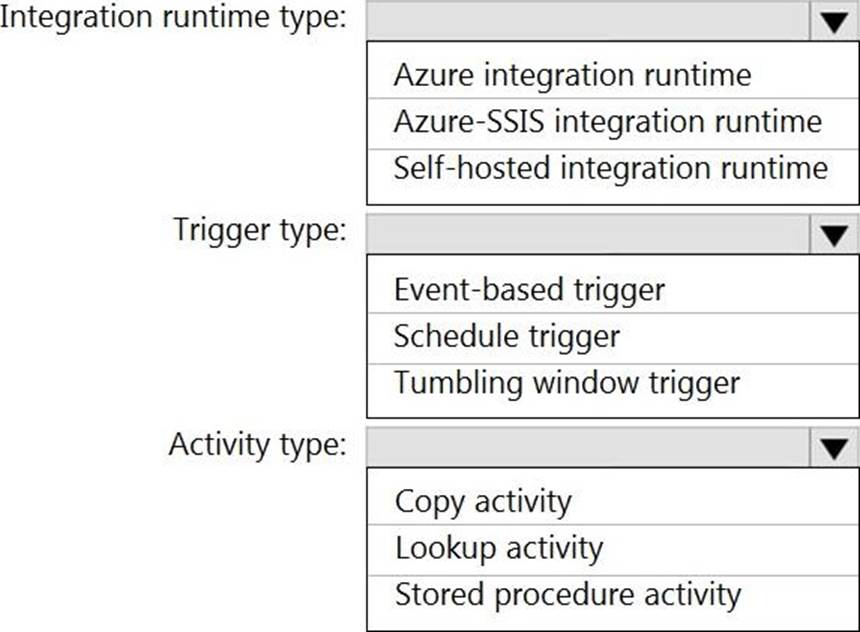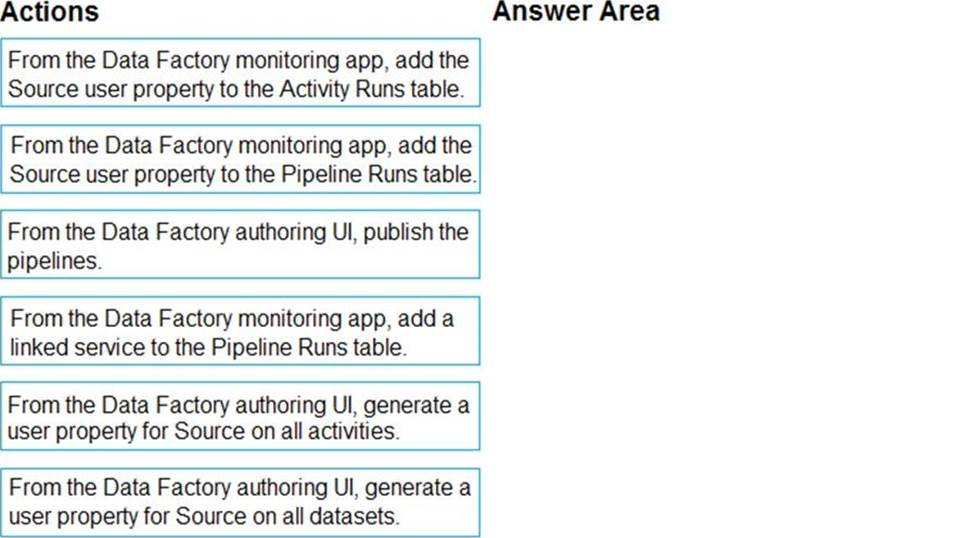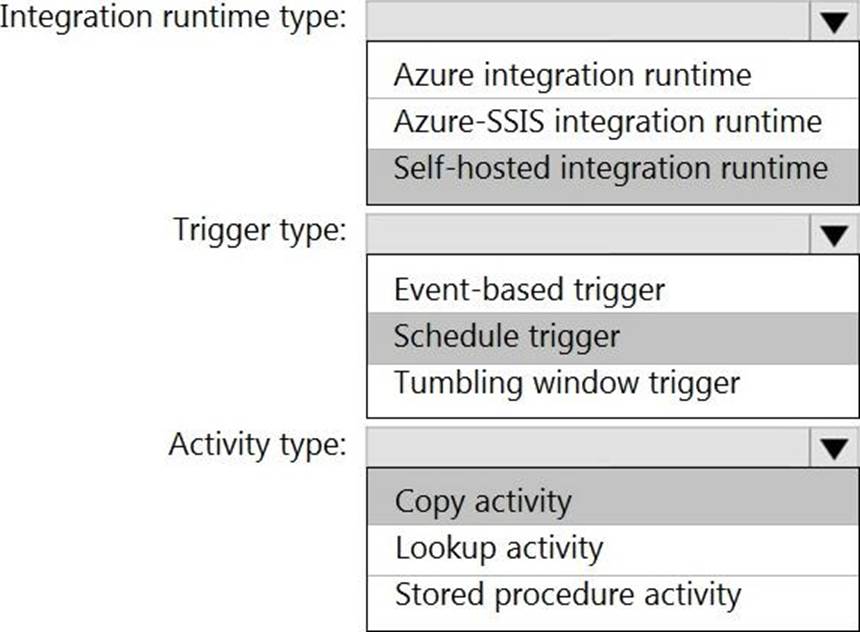Microsoft DP-203 Real Exam Questions
The questions for DP-203 were last updated at Nov 27,2025.
- Exam Code: DP-203
- Exam Name: Data Engineering on Microsoft Azure
- Certification Provider: Microsoft
- Latest update: Nov 27,2025
You are planning a streaming data solution that will use Azure Databricks. The solution will stream sales transaction data from an online store.
The solution has the following specifications:
* The output data will contain items purchased, quantity, line total sales amount, and line total tax amount.
* Line total sales amount and line total tax amount will be aggregated in Databricks.
* Sales transactions will never be updated. Instead, new rows will be added to adjust a sale.
You need to recommend an output mode for the dataset that will be processed by using Structured Streaming. The solution must minimize duplicate data.
What should you recommend?
- A . Append
- B . Update
- C . Complete
Topic 2, Litware, inc.
Case study
This is a case study. Case studies are not timed separately. You can use as much exam time as you would like to complete each case. However, there may be additional case studies and sections on this exam. You must manage your time to ensure that you are able to complete all questions included on this exam in the time provided.
To answer the questions included in a case study, you will need to reference information that is provided in the case study. Case studies might contain exhibits and other resources that provide more information about the scenario that is described in the case study. Each question is independent of the other questions in this case study.
At the end of this case study, a review screen will appear. This screen allows you to review your answers and to make changes before you move to the next section of the exam. After you begin a new section, you cannot return to this section.
To start the case study
To display the first question in this case study, click the Next button. Use the buttons in the left pane to explore the content of the case study before you answer the questions. Clicking these buttons displays information such as business requirements, existing environment, and problem statements. If the case study has an All Information tab, note that the information displayed is identical to the information displayed on the subsequent tabs. When you are ready to answer a question, click the Question button to return to the question.
Overview
Litware, Inc. owns and operates 300 convenience stores across the US. The company sells a variety of packaged foods and drinks, as well as a variety of prepared foods, such as sandwiches and pizzas.
Litware has a loyalty club whereby members can get daily discounts on specific items by providing their membership number at checkout.
Litware employs business analysts who prefer to analyze data by using Microsoft Power BI, and data scientists who prefer analyzing data in Azure Databricks notebooks.
Requirements
Business Goals
Litware wants to create a new analytics environment in Azure to meet the following requirements:
✑ See inventory levels across the stores. Data must be updated as close to real time as possible.
✑ Execute ad hoc analytical queries on historical data to identify whether the loyalty club discounts increase sales of the discounted products.
✑ Every four hours, notify store employees about how many prepared food items to produce based on historical demand from the sales data.
Technical Requirements
Litware identifies the following technical requirements:
✑ Minimize the number of different Azure services needed to achieve the business goals.
✑ Use platform as a service (PaaS) offerings whenever possible and avoid having to provision virtual machines that must be managed by Litware.
✑ Ensure that the analytical data store is accessible only to the company’s on-premises network and Azure services.
✑ Use Azure Active Directory (Azure AD) authentication whenever possible.
✑ Use the principle of least privilege when designing security.
✑ Stage Inventory data in Azure Data Lake Storage Gen2 before loading the data into the analytical data store. Litware wants to remove transient data from Data Lake Storage once the data is no longer in use. Files that have a modified date that is older than 14 days must be removed.
✑ Limit the business analysts’ access to customer contact information, such as phone numbers, because this type of data is not analytically relevant.
✑ Ensure that you can quickly restore a copy of the analytical data store within one hour in the event of corruption or accidental deletion.
Planned Environment
Litware plans to implement the following environment:
✑ The application development team will create an Azure event hub to receive real-time sales data, including store number, date, time, product ID, customer loyalty number, price, and discount amount, from the point of sale (POS) system and output the data to data storage in Azure.
✑ Customer data, including name, contact information, and loyalty number, comes from Salesforce, a SaaS application, and can be imported into Azure once every eight hours. Row modified dates are not trusted in the source table.
✑ Product data, including product ID, name, and category, comes from Salesforce and can be imported into Azure once every eight hours. Row modified dates are not trusted in the source table.
✑ Daily inventory data comes from a Microsoft SQL server located on a private network.
✑ Litware currently has 5 TB of historical sales data and 100 GB of customer data. The company expects approximately 100 GB of new data per month for the next year.
✑ Litware will build a custom application named FoodPrep to provide store employees with the calculation results of how many prepared food items to produce every four hours.
✑ Litware does not plan to implement Azure ExpressRoute or a VPN between the on-premises network and Azure.
HOTSPOT
Which Azure Data Factory components should you recommend using together to import the daily inventory data from the SQL server to Azure Data Lake Storage? To answer, select the appropriate options in the answer area. NOTE: Each correct selection is worth one point.

You use Azure Stream Analytics to receive Twitter data from Azure Event Hubs and to output the data to an Azure Blob storage account.
You need to output the count of tweets during the last five minutes every five minutes. Each tweet must only be counted once.
Which windowing function should you use?
- A . a five-minute Session window
- B . a five-minute Sliding window
- C . a five-minute Tumbling window
- D . a five-minute Hopping window that has one-minute hop
HOTSPOT
You need to implement an Azure Databricks cluster that automatically connects to Azure Data Lake Storage Gen2 by using Azure Active Directory (Azure AD) integration.
How should you configure the new cluster? To answer, select the appropriate options in the answer area. NOTE: Each correct selection is worth one point.

You are developing a solution that will stream to Azure Stream Analytics. The solution will have both streaming data and reference data.
Which input type should you use for the reference data?
- A . Azure Cosmos DB
- B . Azure Blob storage
- C . Azure IoT Hub
- D . Azure Event Hubs
HOTSPOT
You need to output files from Azure Data Factory.
Which file format should you use for each type of output? To answer, select the appropriate options in the answer area. NOTE: Each correct selection is worth one point.

You have an Azure Synapse Analytics serverless SQL pool named Pool1 and an Azure Data Lake Storage Gen2 account named storage1. The AllowedBlobpublicAccess porperty is disabled for storage1.
You need to create an external data source that can be used by Azure Active Directory (Azure AD)
users to access storage1 from Pool1.
What should you create first?
- A . an external resource pool
- B . a remote service binding
- C . database scoped credentials
- D . an external library
You use Azure Data Lake Storage Gen2.
You need to ensure that workloads can use filter predicates and column projections to filter data at the time the data is read from disk.
Which two actions should you perform? Each correct answer presents part of the solution. NOTE: Each correct selection is worth one point.
- A . Reregister the Microsoft Data Lake Store resource provider.
- B . Reregister the Azure Storage resource provider.
- C . Create a storage policy that is scoped to a container.
- D . Register the query acceleration feature.
- E . Create a storage policy that is scoped to a container prefix filter.
You are designing a partition strategy for a fact table in an Azure Synapse Analytics dedicated SQL pool.
The table has the following specifications:
• Contain sales data for 20,000 products.
• Use hash distribution on a column named ProduclID,
• Contain 2.4 billion records for the years 20l9 and 2020.
Which number of partition ranges provides optimal compression and performance of the clustered columnstore index?
- A . 40
- B . 240
- C . 400
- D . 2,400
DRAG DROP
You plan to monitor an Azure data factory by using the Monitor & Manage app.
You need to identify the status and duration of activities that reference a table in a source database.
Which three actions should you perform in sequence? To answer, move the actions from the list of actions to the answer are and arrange them in the correct order.





